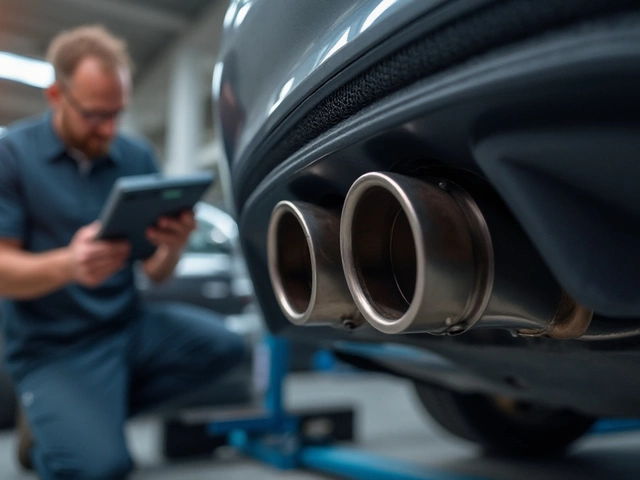Ever been cruising along the highway and suddenly your car starts acting like it’s got a mind of its own? If you’ve been noticing weird noises or your car just doesn't have the oomph it used to, your fuel pump might be the culprit. Let's figure out how to tell if a bad fuel pump is messing with your ride.
So, what's the first sign of trouble? More often than not, it's a hesitant engine. If your car feels like it's about to stall every time you hit the gas, that’s a red flag. Another thing to watch for is sputtering at high speeds. Your engine needs a steady flow of fuel, and a weak pump just can't deliver.
But it's not all doom and gloom; with a little know-how, you can do some checks yourself. Got a fuel pressure gauge? It can help pinpoint the issue. Low pressure could mean a struggling pump. No gauge? Listen for a buzzing sound from the fuel tank area when you turn the key—it should be smooth, not erratic or quiet.
While some issues can be fixed with a little elbow grease, don’t be shy to ask for help if things get tricky. A pro can double-check your diagnosis and ensure there’s nothing else lurking under the hood. Remember, better safe than sorry when it comes to keeping that engine purring.
Recognizing the Symptoms
So your car's acting up and you're suspecting it might be the fuel pump? Here are some clear signs that it's time to take a closer look.
Engine Performance Issues
If your engine starts sputtering when you're driving at high speeds, it might be a sign of a bad fuel pump. When the pump fails, it can’t deliver the right amount of fuel to the engine, leading to uneven operation and power loss.
Starting Problems
Struggling to start your car in the morning? A compromised fuel pump means insufficient fuel pressure to get the engine up and running. This can often manifest as repeated attempts to start before the engine finally turns over.
Random Power Surges
Dramatic power surges are another symptom. Imagine cruising normally, when suddenly your car bolts forward. This happens when the worn-out pump delivers fuel inconsistently, fluctuating the power output abruptly.
Engine Stalling
One of the most frustrating signs of a failing fuel pump is engine stalling. This usually happens as a temporary issue before the pump fails entirely. Drivers often notice intermittent stalls right after the car starts and after it’s been running for some time.
Noise from the Fuel Tank
Take a listen for some unusual noises. Is there a low whining sound coming from your fuel tank? A functional pump usually makes a soft humming noise, but a loud, unusual sound could mean trouble is brewing.
If you're ticking several of these signs off your list, it's likely time for a deeper inspection. Keeping an eye on these symptoms can prevent minor annoyances from becoming major headaches.
Testing and Diagnosis
Think your fuel pump is acting up? Time to play detective! Before you dive into repairs, you'll want to make sure it's really the pump causing your issues. Here’s how you can test and diagnose.
Listen Up
Start simple: turn your ignition key to the 'on' position, but don't start the car. You should hear a hum from the fuel tank. If you’re straining to hear it or it sounds off, your pump might be struggling.
Fuel Pressure Check
If you've got a fuel pressure gauge, testing becomes a breeze. Hook it up to the schrader valve on the fuel rail. You're looking for a reading within your car's prescribed range (usually between 30 to 45 PSI for most vehicles). A number too low or high points to pump issues.
Voltage Test
No fuel pressure gauge? No sweat. Use a multimeter to test voltage at the fuel pump connector. You should see around 12 volts. Anything less and your pump may not be getting enough juice, or there could be a problem with the wiring.
Scan Tool Findings
If you've got access to an OBD-II scanner, this can be another ally. Check for any stored trouble codes that might indicate a bad fuel pump or related fuel system issues.
Quick Tips
- Always ensure your fuel tank has enough gas before testing. Running on empty can mimic pump failure symptoms.
- If you’re hearing noises while your car idles or drives, cross-check that it’s not coming from your exhaust system or suspension for accurate diagnosis.
By thoroughly checking these areas, you can confidently pinpoint if a bad fuel pump is behind your car’s woes or if something else is the culprit. Knowing what to look for makes tackling car troubles much less daunting.

DIY Checks and Fixes
If you suspect your bad fuel pump is the gremlin behind your car's issues, there are some simple checks you can do at home before calling in a pro. These DIY steps aren't too tricky and can save you a headache or two down the line.
Listen and Diagnose
First off, use your ears. When you turn the ignition to the 'on' position, take a moment to listen for any sounds from the fuel tank. A healthy pump will hum for a few seconds—anything else, like a loud whirring or no sound at all, might mean trouble.
Check the Fuel Filter
Sometimes it's not the fuel pump but a clogged fuel filter that's causing issues. A blocked filter can starve the engine of fuel. It’s a good idea to check or change your filter every 20,000 to 40,000 miles. If you haven’t done this in a while, consider giving it a look.
Inspect for Leaks
Take a peek underneath the car and around the engine for any signs of fuel leaks. Leaks can not only affect pump performance but are also downright dangerous. If you smell gasoline or see puddles, it’s time to fix or call for help.
Test the Fuel Pressure
A simple tool like a fuel pressure gauge can be a lifesaver here. Hook it up to your car's fuel line as per the gauge's instructions. Start the engine and check the pressure reading:
- If the reading is lower than the car's manual suggests, your fuel pump might need a replacement.
- If the pressure reads too high, it could indicate a problem elsewhere in the fuel system.
Jumper Cables Quick Test
If you have some mechanical savvy, you can try a fuel pump jump-start. By connecting a jumper cable directly to the fuel pump wiring, you can see if it springs back to life. This isn’t a fix, but it helps confirm the pump is the issue.
Remember, while DIY checks can give you a clue, if things aren’t adding up, don’t hesitate to call a professional. They can provide a thorough diagnostics and ensure there's nothing more serious at play.
When to Call the Pros
Sometimes, no matter how handy you are, there comes a point when getting professional help for diagnosing a bad fuel pump is just the smart move. If you're noticing persistent issues that don’t seem to go away after basic DIY tests, it's better to get a mechanic involved.
One obvious cue is the Check Engine light. Sure, it can be triggered by a bunch of things, but if it's coupled with symptoms like stalling or poor performance, don't wait too long.
Complex Diagnoses
The tools beyond a basic wrench and screwdriver might be out of reach for many of us. Advanced fuel system diagnostics often require specialized equipment that only a professional mechanic might have access to. Plus, they can catch problems that are easy to overlook.
If you're spending more time worrying under the hood than driving, it's time to dial a mechanic – Jane Lund, Automotive Expert.
Replacing Parts
If you ever need parts replaced like the whole pump mechanism, professionals make sure it’s done right. They confirm compatibility and ensure everything fits and functions properly.
A quick glance at a fuel pump replacement might set you back around $400-$600 for parts and labor. But think of it as investing in peace of mind.
- The car is less responsive when accelerating.
- The engine frequently stalls.
- The fuel pump's noise is more noticeable or strange.
| Fuel Pump Issues | Professional Inspection Recommended |
|---|---|
| Check Engine light on | Yes |
| Consistent poor performance | Yes |
| Multiple DIY fixes failed | Yes |
So, when should you call the pros? If you're dealing with serious symptoms, specialized tools required, or peace of mind during complex part replacement, don’t hesitate to get a mechanic’s eye over it. It could save you more than a few bucks in the long run.




